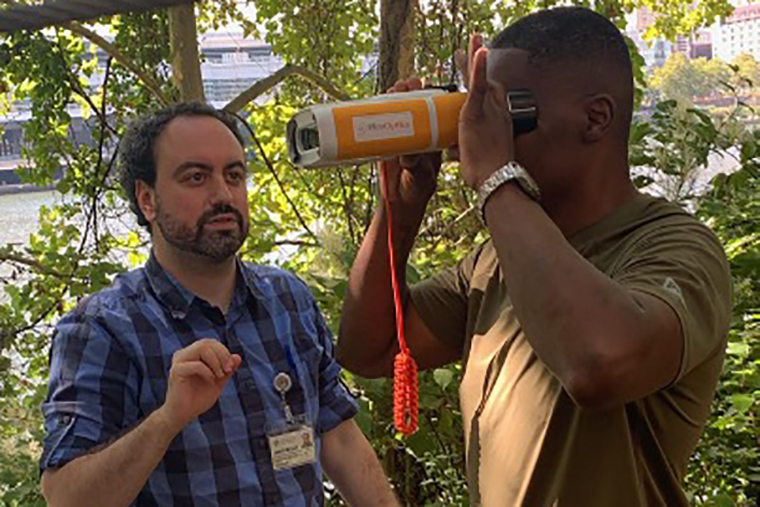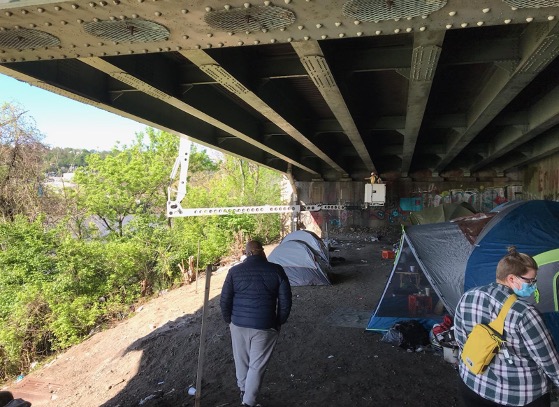
To make an impact in the persistent problem of vision impairment among the people experiencing homelessness in Pittsburgh, the Street Medicine Team of the Allegheny Health Network included QuickSee in their backpack kit. “This has really become a wonderful tool,” said James Miller, MD, a co-leader of the care initiative. “The community has gotten really excited about this, more people are asking us for glasses…it’s kind of snowballing.”
The Allegheny Health Network’s Street Medicine Institute engages and treats people who are sleeping rough—that is, on the streets overnight. People experiencing homelessness suffer visual impairments at higher rates than average for their age groups, so the team hypothesized that adding vision care to their services would make a significant quality of life impact for their patients. “We definitely want to make sure that the glasses go to people that are going to be able to see better by their use,” said Patricia Nelson, MD, FACS, an ophthalmologist at the Minnesota Eye Institute, who participated in protocol design and results analysis remotely.
The team, which was composed of MDs, nurses, and community outreach workers, carried a “go bag” that included a QuickSee, an Early Treatment Diabetic Retinopathy Study (ETDRS) chart, and pinhole occluder. They also brought tools to measure pupillary distance. The team chose QuickSee based on a review of the scientific literature1 that showed it had the most accurate and reliable results, with strong clinical evidence across multiple IRB-based clinical studies and randomized controlled trials.
The protocol the team designed included about six steps over two encounters. First, they would test patients with the eye chart and the pinhole ring to determine if they had refractive error, and if they showed potential for at least two lines of improvement with correction. In this case, the team would use QuickSee to get autorefraction measurements.
Related:
Scaling a solution to the global burden of uncorrected refractive error
Restoring vision where much was lost
20/20 vision for eyes—and lives
With the QuickSee measurements, they would order eyeglasses from an online retailer for an average cost of $23. In the second encounter a short while later, patients were fitted with the glasses and reexamined for improvement. The patients were also surveyed about their satisfaction with the process.
The team presented the results of their initial work, which they called the SMART Study (Street Medicine Auto-Refractive Technology) at the International Street Medicine Symposium in Toronto, Canada in September 2022. At that time, they had screened 69 patients. 45 patients were found to need glasses. Glasses improved visual acuity by ~3 lines on the eye chart for both the right and left eyes.
This simple intervention had a predictably powerful impact on people. “I had given up on being able to see,” said one person who received glasses. Another was able to get his commercial driver’s license because of his new glasses and improved vision.
People found to have eye health issues that couldn’t be solved with eyeglasses were referred to community ophthalmologists. The street medicine found this to be a crucial outcome of the initiative.
“Our protocol is not only giving glasses, but really screening this population as well,” said Anindya “Jay” Samanta, MD, an ophthalmology resident at Texas Tech University School of Medicine and a study co-designer. “If we can treat this population with refractive error this way, we can focus on the people that actually need further follow up in clinic.” The team believes community health workers could carry out the vision screenings with training and a clear protocol.
Dr Miller believes the vision care outreach initiative has potential for more profound impact—they are finding it’s a tool to engage individuals experiencing homelessness who have trouble accessing care and who may distrust the health system. “It creates an entry point for the street medicine team,” he said. “Vision loss is very important to people but also feels less invasive. We’re able to start a conversation about health needs, and build trust, almost immediately, when we give glasses. We’re doing something that instantly has a reward.”

The street medicine team visited patients where they lived, with special focus on those sleeping outdoors. Photo courtesy Dr James Miller
At top: Dr Miller refracting a patient with QuickSee. The street medicine team carried everything they needed for a visual acuity exam in a backpack. Photo courtesy Dr James Miller
1. Samanta A, Mauntana S, Barsi Z, Yarlagadda B, Nelson PC. Is your vision blurry? A systematic review of home-based visual acuity for telemedicine. J Telemed Telecare. 2023 Feb;29(2):81-90. doi: 10.1177/1357633X20970398. Epub 2020 Nov 22. PMID: 33222600.
*The intended use of QuickSee is to objectively measure a patient’s refractive errors, to provide a starting point for subjective refraction performed by a vision care professional.
Allegheny Health Network Street Medicine Team
James Miller, MD
Allegheny Health Network Center for Inclusion Health Street Medicine Program
Max Jacobs, DO
Allegheny Health Network
Shikha Bhatia, MD, MPH
Ascension Tennessee Saint Thomas Hospital West
Anindya Samanta, MD
Texas Tech University Health Sciences Center
Patricia Nelson, MD, FACS
Minnesota Eye Institute
Please note: Our Privacy policy and Terms of service were updated on September 30, 2025
Are you ready to learn how to use QuickSee Free / Free Pro effectively? Tell us about yourself and your circumstances and we will reach out to arrange a training session with you.